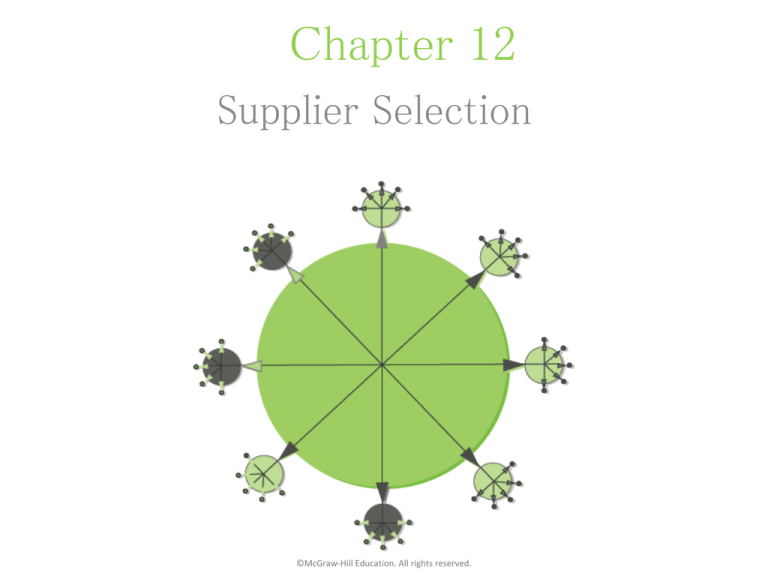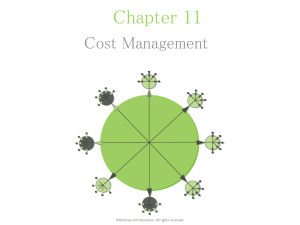
Chapter 12
Supplier Selection
©McGraw-Hill Education. All rights reserved.
Key Questions Addressed in
Chapter 12
• How can the supply professional match the
organization’s needs to what the market can
supply?
• Which supplier(s) should be selected?
Identification of Potential
Sources
1.
Can We
Make In-House?
Yes
2. Can a Current
Supplier
Meet?
No
Yes
Make
Buy
One
Supplier
Can Meet
Two or More
Suppliers
Can Meet
3.
Find Potential
New Supplier
No
No
Supplier
Can Meet
One
Supplier
Can Meet
Two or More
Suppliers
Can Meet
Can We Use
Supplier
Development to
Create Supplier?
Yes
Yes
Can We Make
In-House?
No
Rethink
No
Can We
Redesign/Re-specify
so that
Existing or New Supplier
Can Meet?
©McGraw-Hill Education. All rights reserved.
Yes
3
Supplier Selection Decisions
• Should we use a single source, dual sources, or
more than two?
• Should we buy from a manufacturer or a
distributor?
• Where should the supplier be located?
• Relative to our organization, should the supplier
be small, medium, or large?
• If no supplier can be found, should we use
supplier development?
©McGraw-Hill Education. All rights reserved.
4
Supplier Development Initiative
The Marketing Context
Marketing Initiative
Supplier
Supply Response
Purchaser
The Supplier Development Context
Supplier
Sales Response
Purchaser
Supply Initiative
©McGraw-Hill Education. All rights reserved.
5
Key Supplier Evaluation Question
• Is this supplier able to supply the purchaser’s
requirements satisfactorily?
– strategically and operationally
– in the short and long term
Three Levels of Supplier
Evaluation
• Level 1 – Strategic
• Level 2 – Traditional: quality, quantity,
delivery, price and service
– Technical, engineering, manufacturing and
logistics strengths
– Management and financial evaluation
• Level 3 – Current Additional: financial, risk,
environmental, regulatory, innovation, social
and political
©McGraw-Hill Education. All rights reserved.
7
Formal Supplier Evaluations
• Quality
Good Performance
• Price
• Delivery
Fair Performance
• Service
Unsatisfactory Performance
©McGraw-Hill Education. All rights reserved.
8
Supply Risks and Dollars
Extended
Risk
High
Bottleneck
• Unique specification
• Supplier technology
important
• Production-based scarcity
• Substitution difficult
• Usage fluctuates
• Potential storage risk
Strategic
• Continuous availability essential
• Custom design or unique
specifications
• Supplier technology important
• Few adequate suppliers
• Changing source of supply difficult
• Substitution difficult
Non-Critical
• Standard or commodity type
• Substitute products available
• Competitive supply market
Leverage
• Unique cost management important
• Substitution possible
• Competitive supply market
Source: Peter Kraljic,
Purchasing Must
Become Supply
Management,”
Harvard Business
Review, SeptemberOctober, 1983
Low
Low
Value
©McGraw-Hill Education. All rights reserved.
High
9
Weighted Point Evaluation
Systems
• Identify suppliers
– Important suppliers and/or critical goods and services
• Identify factors or criteria for evaluation
• Determine the importance of each factor
• Establish a system to rate each supplier on each
factor
©McGraw-Hill Education. All rights reserved.
10
Evaluation of Potential Sources:
Two Key Questions
1. Is this supplier capable of supplying our
requirements satisfactorily in both the shortand long-term?
2. Is this supplier motivated to supply these
requirements in the way we expect in the
short- and long-term?
©McGraw-Hill Education. All rights reserved.
11







